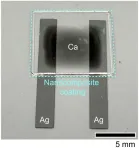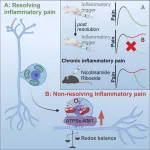(Press-News.org) Research consortium investigators analyzed over 314,000 cells from rheumatoid arthritis tissue, defining six types of inflammation involving diverse cell types and disease pathways
Understanding the disease at single-cell level may advance targeted drug development and treatment strategies
Rheumatoid arthritis (RA) is an autoimmune disease characterized by inflammation that leads to pain, joint damage, and disability, which affects approximately 18 million people worldwide. While RA therapies targeted to specific inflammatory pathways have emerged, only some patients’ symptoms improve with treatment, emphasizing the need for multiple treatment approaches tailored to different disease subtypes. To more precisely define cellular drivers of RA, an international research consortium co-led by researchers from the Broad Institute of MIT and Harvard and Brigham and Women’s Hospital, a founding member of the Mass General Brigham healthcare system, analyzed tissues from RA donors at the single-cell level, integrating multiple forms of analysis to stratify RA by six subtypes of inflammation. Findings, published in Nature, shed new light on the variety of cellular causes of RA, which may inform more targeted, effective and patient-tailored therapeutic approaches.
“In the treatment of individuals with rheumatoid arthritis, we struggle to find the right treatment for the right patient,” said corresponding author Soumya Raychaudhuri, MD, PhD, of the Brigham’s Division of Rheumatology, Inflammation and Immunity and the Broad Institute, where he is an institute member. “We aimed to determine why some subsets of patients don’t respond to conventional treatments by looking at the subtypes of inflammation. We did so from many different angles, using multiple cutting-edge, single-cell techniques and integrating results in a way that hasn’t been done before for an inflammatory disease.”
The findings from the study represent a major milestone in the Accelerating Medicines Partnership Rheumatoid Arthritis and Systemic Lupus Erythematosus program, a public-private partnership launched in 2014 to advance molecular- and cellular-level understandings of autoimmune diseases and identify promising drug targets. Through collaboration with researchers and clinicians across the U.S. and U.K., the investigators analyzed 79 donor samples of synovial tissue, the inflamed tissue in RA that normally helps cushion and sustain joints. In particular, the researchers examined tissue from patients with new-onset disease and from patients unresponsive to treatment to better identify both the initial drivers of RA as well as those of refractory disease.
To “deconstruct” RA pathology on a cellular level, the researchers combined surface protein data and histologic analysis with multiple forms of single-cell RNA-sequencing and bulk RNA sequencing. Despite the variety of methods used to analyze over 314,000 cells, the researchers consistently found evidence of six major types of inflammation, which they stratified by associated cell type, called cell-type abundance phenotypes (CTAPs). While some CTAPS, such as those enriched with T and B cells, were expected finding for an autoimmune disease like RA, the researchers were surprised to see CTAPs associated with structural cells such as fibroblasts and endothelial cells, with relatively few inflammatory leukocytes. They also found that patients’ CTAPs were dynamic and could change over time in response to treatment.
Going forward, the researchers aim to expand upon their knowledge of the cell types involved in RA by studying how interconnections between cells promote disease states. Furthermore, they hope this work will encourage increased synovial tissue analysis in RA patients, which is currently not standard practice. While blood tests are more common in RA patients, findings from this study and others emphasize that the cellular profile of synovial tissue differs substantially from that of blood.
“What this study shows is that the tissue matters,” said co-senior author Michael Brenner, MD, of the Brigham’s Division of Rheumatology, Inflammation and Immunity. “Our findings point to the value of getting synovial tissue biopsies to evaluate the nature of the pathological process, which can be so different across patients. Clinical trials going forward will benefit greatly from assessing tissue characteristics alongside responses to a therapy. By providing this atlas of cell types and pathways involved in RA, we are better able to pursue our precision medicine goal of being able to select the right drug for the right patient and achieve a high response rate.”
Disclosures: Raychaudhuri is a founder for Mestag Therapeutics, a scientific advisor for Janssen and Pfizer, and a consultant for Gilead and Rheos Medicines. Brenner is a founder for Mestag Therapeutics and a consultant for GlaxoSmithKline, 4FO Ventures and Scailyte AG. A complete list of disclosures is available in the article.
Funding: This work was supported by the Accelerating Medicines Partnership (AMP) in Rheumatoid Arthritis and Lupus Network, a public- private partnership (AbbVie, Arthritis Foundation, Bristol-Myers Squibb Company, Foundation for the National Institutes of Health, GlaxoSmithKline, Janssen Research and Development, Lupus Foundation of America, Lupus Research Alliance, Merck Sharp and Dohme, National Institute of Allergy and Infectious Diseases, National Institute of Arthritis and Musculoskeletal and Skin Diseases, Pfizer, Rheumatology Research Foundation, Sanofi and Takeda Pharmaceuticals International). Funding was provided through grants from the National Institutes of Health (UH2-AR067676, UH2-AR067677, UH2-AR067679, UH2-AR067681, UH2-AR067685, UH2- AR067688, UH2- AR067689, UH2-AR067690, UH2-AR067691, UH2-AR067694 and UM2- AR067678), as well as NIH grants to Raychaudhuri (NHGRI U01HG009379 and NIAMS R01AR063759) and Brenner (NIAMS R01AR073833 and R01AR073290). A complete list of funding is available in the article.
Paper cited: Zhang, F et al. “Deconstruction of rheumatoid arthritis synovium defines inflammatory subtypes” Nature DOI: 10.1038/s41586-023-06708-y
Authorship: Co-first authors are Fan Zhang (University of Colorado Anschutz Medical Campus), Anna Helena Jonsson (BWH), Aparna Nathan (Harvard University), and Nghia Millard (BWH). Co-senior authors alongside Raychaudhuri and Brenner are Kevin Wei (BWH), Deepak Rao (BWH), Laura Donlin (Hospital for Special Surgery) and Jennifer Anolik (University of Rochester Medical Center).
BWH co-authors include Qian Xiao, Maria Gutierrez-Arcelus, Gerald Watts, Dana Weisenfeld, Joyce Kang, Laurie Rumker, Joseph Mears, Kathryn Weinand, Ellen Gravallese, Katherine P Liao, Michelle Curtis, Kathryne Marks, Michelle Curtis, Qian Xiao, Maria Gutierrez-Arcelus, Gerald F. M. Watts, Dana Weisenfeld, Kathryne E. Marks, Joyce B. Kang, Laurie Rumker, Joseph Mears, Kathryn Weinand, Ellen Gravallese, Adam Chicoine, Kazyoshi Ishigaki, Gregory Keras, Ilya Korsunksy, James A. Lederer, Zhihan Li, Yhong Li, Yakir Reshef, Saori Sakaue, Zhu Zhu, Katherine Liao.
Additional authors include William Apruzzese, Kamil Slowikowski, Dana Orange, Javier Rangel-Moreno, Laura Geraldino-Pardilla, Kevin Deane, Darren Tabechian, Arnoldas Ceponis, Gary Firestein, Mark Maybury, Ilfita Sahbudin, Ami Ben-Artzi, Arthur Mandelin II, Alessandra Nerviani, Felice Rivellese, Costantino Pitzalis, Laura Hughes, Diane Horowitz, Edward DiCarlo, Brendan Boyce, Larry Moreland, Susan Goodman, Harris Perlman, Michael Holers, Andrew Filer, Vivian Bykerk, Saba Nayar, Nida Meednu, Ian Mantel, Myles Lewis
END
Cellular “atlas” built to guide precision medicine treatment of rheumatoid arthritis
Research consortium investigators analyzed over 314,000 cells from rheumatoid arthritis tissue, defining six types of inflammation involving diverse cell types and disease pathways
2023-11-08
ELSE PRESS RELEASES FROM THIS DATE:
Estimated effectiveness of co-administration of the Pfizer-BioNTech COVID-19 vaccine with influenza vaccine
2023-11-08
About The Study: In this study that included 3.4 million adults, co-administration of the BNT162b2 BA.4/5 bivalent mRNA COVID-19 vaccine (Pfizer-BioNTech) and seasonal influenza vaccine was associated with generally similar effectiveness in the community setting against COVID-19–related and seasonal influenza vaccine-related outcomes compared with giving each vaccine alone and may help improve uptake of both vaccines.
Authors: Leah J. McGrath, Ph.D., of Pfizer Inc., in New York, is the corresponding author.
To ...
Age at diagnosis of atrial fibrillation and incident dementia
2023-11-08
About The Study: Earlier onset of atrial fibrillation was associated with an elevated risk of subsequent all-cause dementia, Alzheimer disease, and vascular dementia in this study including 433,000 UK Biobank participants, highlighting the importance of monitoring cognitive function among patients with atrial fibrillation, especially those younger than 65 years at diagnosis.
Authors: Fanfan Zheng, Ph.D., of the Chinese Academy of Medical Sciences & Peking Union Medical College in Beijing, and Wuxiang Xie, Ph.D., of the Peking University First ...
Physicists trap electrons in a 3D crystal for the first time
2023-11-08
Electrons move through a conducting material like commuters at the height of Manhattan rush hour. The charged particles may jostle and bump against each other, but for the most part they’re unconcerned with other electrons as they hurtle forward, each with their own energy.
But when a material’s electrons are trapped together, they can settle into the exact same energy state and start to behave as one. This collective, zombie-like state is what’s known in physics as an electronic “flat band,” and scientists predict that when electrons are in this state they can start to ...
Scaling up nano for sustainable manufacturing
2023-11-08
A new self-assembling nanosheet could radically accelerate the development of functional and sustainable nanomaterials for electronics, energy storage, health and safety, and more.
Developed by a team led by Lawrence Berkeley National Laboratory (Berkeley Lab), the new self-assembling nanosheet could significantly extend the shelf life of consumer products. And because the new material is recyclable, it could also enable a sustainable manufacturing approach that keeps single-use packaging and electronics out of landfills.
The ...
Validating the role of inhibitory interneurons in memory
2023-11-08
Memory, a fundamental tool for our survival, is closely linked with how we encode, recall, and respond to external stimuli. Over the past decade, extensive research has focused on memory-encoding cells, known as engram cells, and their synaptic connections. Most of this research has centered on excitatory neurons and the neurotransmitter glutamate, emphasizing their interaction between specific brain regions.
To expand the understanding of memory, a research team led by KAANG Bong-Kiun (Seoul National University, Institute ...
Scientists tame biological trigger of deadly Huntington’s disease
2023-11-08
Huntington’s disease causes involuntary movements and dementia, has no cure, and is fatal. For the first time, UC Riverside scientists have shown they can slow its progression in flies and worms, opening the door to human treatments.
Key to understanding these advancements is the way that genetic information in cells is converted from DNA into RNA, and then into proteins. DNA is composed of chemicals called nucleotides: adenine (A), thymine (T), guanine (G), and cytosine (C). The order of these nucleotides determines what biological instructions are contained in a strand of DNA.
On occasion, some DNA nucleotides repeat themselves, ...
Disturbances in sensory neurons may alter transient pain into chronic pain
2023-11-08
Utrecht, November 8, 2023 - Researchers from the Center for Translational Immunology at University Medical Center Utrecht (the Netherlands) have identified that a transient inflammatory pain causes mitochondrial and redox changes in sensory neurons that persist beyond pain resolution. These changes appear to predispose to a failure in resolution of pain caused by a subsequent inflammation. Additionally, targeting the cellular redox balance prevents and treats chronic inflammatory pain in rodents.
Pain often persists in patients with an ...
SMU Lyle nanorobotics professor awarded prestigious research grant to make gene therapy safer
2023-11-08
DALLAS (SMU) – SMU nanotechnology expert MinJun Kim and his team have been awarded a $1.8 million, R01 grant from the National Institutes of Health (NIH) for research related to gene therapy – a technique that modifies a person’s genes to treat or cure disease.
NIH R01 (Research Program) grants are extremely competitive, with fewer than 10 percent of applicants receiving one.
The four-year grant will allow Kim, the Robert C. Womack Chair in the Lyle School of Engineering at SMU (Southern Methodist University) and principal investigator ...
$200M gift propels scientific research in the search for life beyond earth
2023-11-08
$200m Gift Propels Scientific Research in the Search for Life Beyond Earth
Legacy of Franklin Antonio represents quantum leap for The SETI Institute
November 8, 2023, Mountain View, CA – The SETI Institute, a non-profit scientific research organization, announced today a philanthropic gift of $200m from the estate of Franklin Antonio, a visionary supporter and catalyst of the work of the SETI Institute for more than 12 years. Co-founder of communications chip company, Qualcomm, Antonio passed away on May 13, 2022, leaving behind an extraordinary ...
Blood clotting risk quickly drops after stopping hormonal contraceptives
2023-11-08
(WASHINGTON, Nov. 8, 2023) – Using birth control pills and other hormone-based contraceptives is known to elevate the risk of blood clots about three-fold, but a new study suggests that this risk largely goes away within two to four weeks after one stops using these contraceptives, according to research published today in Blood.
The findings – the first to provide such confirmatory guidance on the best timing to stop contraception – can help patients and doctors weigh the benefits and risks of hormonal contraceptives and guide when to stop using them ahead of events that could further increase the risk of dangerous clots, such as major surgery, ...
LAST 30 PRESS RELEASES:
Tec-Dara combination offers substantial improvement over standard second-line therapies for relapsed or refractory multiple myeloma
Improving treatment for an autoimmune bleeding condition
Drug reduced need for blood transfusions during hospitalization for non-cardiac surgery
Novel agent ianalumab added to standard therapy extends time to treatment failure in patients with previously treated immune thrombocytopenia
Pirtobrutinib outperforms bendamustine plus rituximab for previously untreated CLL/SLL
Online tracking and privacy on hospital websites
A freely available tool to document wartime destruction
Residential solar panels can raise electricity rates
Scientists use synthetic platelets as ‘Trojan horse’ drug-delivery system
Cooperative Intermolecular Interactions Regulate Supramolecular Polymer Assembly
Korea University researchers develop ultrasensitive method to detect low-frequency cancer mutations
First patient enrolled in GOG-3133/ FRAmework-01 phase 3 study evaluating sofetabart mipitecan (LY4170156), a novel ADC targeting folate receptor alpha (FRα), in recurrent ovarian cancer
Two Hebrew University researchers win prestigious ERC consolidator grants
ERC grant helps to quantify the impact of anthropogenic air pollution particles on climate
Exercise might help improve mobility during aging
New online tool detects drug exposure directly from patient samples
Learn the surprising culprit limiting the abundance of Earth’s largest land animals
Study reveals new ways the brain regulates communication between neurons
Research reveals new hybrid state of matter where solids meet liquids
Researchers develop a new computational tool to understand how genetic interactions impact human traits
Elephants, giraffes and rhinos go where the salt is
Cancer loses its sense of time to avoid stress responses
The twisted nanotubes that tell a story
Flaring black hole whips up ultra-fast winds
Study explores the link between newspaper preference and attitudes towards autism
Artificial turf in the Nordic climate – a question of sustainability
The hidden toll of substance use disorder: annual cost of lost productivity to US economy nearly $93 billion
Among psychologists, AI use is up, but so are concerns
Recycling a pollutant to make ammonia production greener
Common institutional ownership linked to less aggressive business strategies in Chinese firms
[Press-News.org] Cellular “atlas” built to guide precision medicine treatment of rheumatoid arthritisResearch consortium investigators analyzed over 314,000 cells from rheumatoid arthritis tissue, defining six types of inflammation involving diverse cell types and disease pathways






